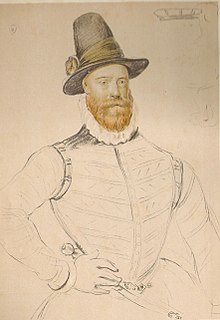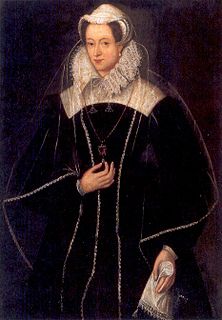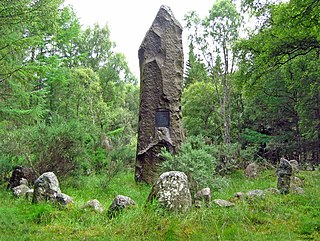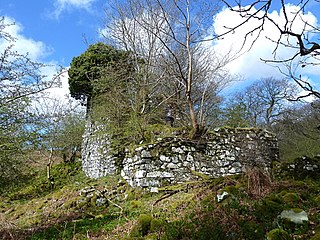Related Research Articles

The Battle of Langside was fought on 13 May 1568 between forces loyal to Mary, Queen of Scots, and forces acting in the name of her infant son James VI. Mary’s short period of personal rule ended in 1567 in recrimination, intrigue, and disaster when, after her capture at Carberry Hill, she was forced to abdicate in favour of James VI, her infant son. Mary was imprisoned in Loch Leven Castle, while her Protestant half-brother, James Stewart, Earl of Moray, was appointed Regent on behalf of his nephew. In early May 1568 Mary escaped, heading west to the country of the Hamiltons, high among her remaining supporters, and the safety of Dumbarton Castle with the determination to restore her rights as queen. Mary was defeated and went into exile and captivity in England. The battle can be regarded as the start of the Marian civil war.

James Douglas,4th Earl of Morton was the last of the four regents of Scotland during the minority of King James VI. He was in some ways the most successful of the four, since he won the civil war that had been dragging on with the supporters of the exiled Mary, Queen of Scots. However, he came to an unfortunate end, executed by means of the Maiden, a predecessor of the guillotine.

James Stewart, 1st Earl of Moray, a member of the House of Stewart as the illegitimate son of King James V, was the regent of Scotland for his half-nephew, the infant King James VI, from 1567 until his assassination in 1570. He was the first head of government to be assassinated with a firearm.
William Douglas, 6th Earl of Morton was the son of Robert Douglas of Lochleven and Margaret Erskine, a former mistress of James V of Scotland.
George Gordon, 5th Earl of Huntly, was Lord Chancellor of Scotland and major conspirator of his time.

The Casket letters were eight letters and some sonnets said to have been written by Mary, Queen of Scots, to the Earl of Bothwell, between January and April 1567. They were produced as evidence against Queen Mary by the Scottish lords who opposed her rule. In particular, the text of the letters was taken to imply that Queen Mary colluded with Bothwell in the murder of her husband, Lord Darnley. Mary's contemporary supporters, including Adam Blackwood, dismissed them as complete forgeries or letters written by the Queen's servant Mary Beaton. The authenticity of the letters, now known only by copies, continues to be debated. Some historians argue that they were forgeries concocted in order to discredit Queen Mary and ensure that Queen Elizabeth I supported the kingship of the infant James VI of Scotland, rather than his mother. The historian John Hungerford Pollen, in 1901, by comparing two genuine letters drafted by Mary, presented a subtle argument that the various surviving copies and translations of the casket letters could not be used as evidence of their original authorship by Mary.
Sir John Bellenden of Auchnole and Broughton was, before 1544, Director of Chancery, and was appointed Lord Justice Clerk on 25 June 1547, succeeding his father Thomas Bellenden of Auchnoule. John was knighted before April 1544.
Thomas Randolph (1523–1590) was an English ambassador serving Elizabeth I of England. Most of his professional life he spent in Scotland at the courts of Mary, Queen of Scots, and her son James VI. While in Scotland, he was embroiled in marriage projects and several upheavals. In 1568-1569 he was sent on a special embassy to Russia, visiting the court of Ivan the Terrible.

The Battle of Corrichie, also known as the Battle of Corrichy was a battle fought near Meikle Tap, near Aberdeen, Scotland, on 28 October 1562. It was fought between the forces of George Gordon, 4th Earl of Huntly, chief of Clan Gordon, against the forces of Mary, Queen of Scots, under James Stewart, 1st Earl of Moray.
Robert Richardson was a Scottish Prior of St Mary's Isle and royal administrator.
Elizabeth Gordon, Countess of Huntly, was a Scottish noblewoman and the wife of George Gordon, 4th Earl of Huntly, Scotland's leading Catholic magnate during the reign of Mary, Queen of Scots. In 1562, Elizabeth encouraged her husband to raise forces against Queen Mary which led to his being outlawed, and after his death, his titles forfeited to the Crown. Elizabeth's son Sir John Gordon was executed for having taken part in his father's rebellion.

Alexander Stewart, 1st Earl of Galloway was a Scottish courtier and landowner.

Kenmure Castle is a fortified house or castle in The Glenkens, 1 mile (1.6 km) south of the town of New Galloway in Kirkcudbrightshire, Galloway, south-west Scotland. The site was occupied from the Middle Ages, and the house incorporates part of a 17th-century castle. This was remodelled in the 19th century, but the house has been derelict since the mid-20th century. It was the seat of the Gordon family of Lochinvar, later raised to the peerage as Viscounts of Kenmure. The ruin is a scheduled monument.
James Stewart, 1st Lord Doune (1529-1590) was a Scottish landowner.
John Stewart, Commendator of Coldingham (1531-1563) was a Scottish landowner.
Timothy Cagnioli was an Italian merchant and banker in Scotland.
Sir John Wishart of Pitarrow was a Scottish lawyer, courtier, comptroller of the exchequer, and rebel
Henry Middlemore was an English courtier and diplomat.
Sir Robert Gordon of Lochinvar was a Scottish landowner, courtier, and promoter of colonies in Nova Scotia.

Alexander Hamilton of Innerwick was a Scottish landowner and supporter of Mary, Queen of Scots.
References
- ↑ Joseph Bain, Calendar of State Papers Scotland, vol. 1 (Edinburgh, 1898), p. 15 no. 34.
- ↑ HMC 5th Report: Marquis of Ailsa (London, 1876), p. 615.
- ↑ James Balfour Paul, Scots Peerage, vol. 5 (Edinburgh, 1908), p. 110
- ↑ Joseph Stevenson, History of Mary Stewart by Claude Nau (Edinburgh, 1883), pp. 95, 294.
- ↑ Calendar State Papers Scotland: 1563-1569, vol. 2 (Edinburgh, 1900), pp. 444, 445.
- ↑ Joseph Bain, Calendar State Papers Scotland: 1563-1569, vol. 2 (Edinburgh, 1900), p. 437 no. 706.
- ↑ Robert Vans Agnew, Correspondence of Sir Robert Waus of Barnbarroch, vol. 2 (Edinburgh, 1887), pp. 414-5.
- ↑ Calendar State Papers Scotland, vol. 10 (Edinburgh, 1936), p. 852.
- ↑ Joseph Bain, Calendar of Border Papers, vol. 1 (London, 1894), pp. 411-2.
- ↑ Calendar State Papers Scotland: 1597-1603, vol. 13 (Edinburgh, 1969), pp. 576, 1003.
- ↑ Reliquiæ Antiquæ Scoticæ, vol. 1 (Edinburgh, 1848), pp. 1-5.
- ↑ Calendar State Papers Scotland: 1589-1593, vol. 10 (Edinburgh, 1936), p. 300.